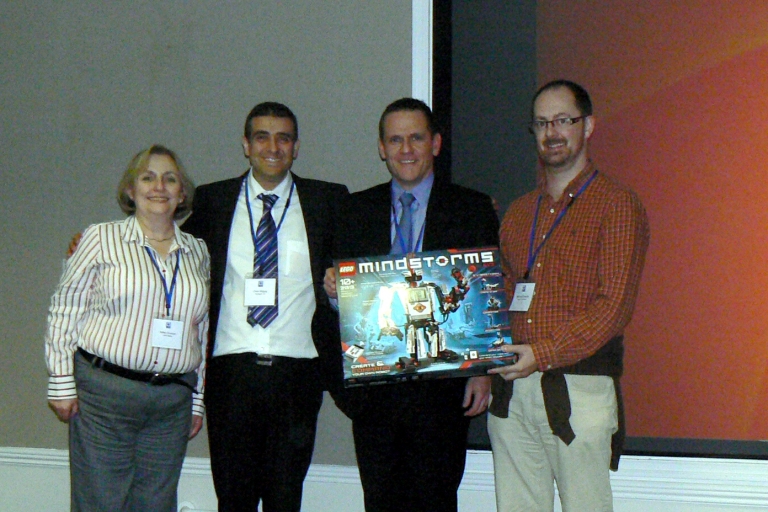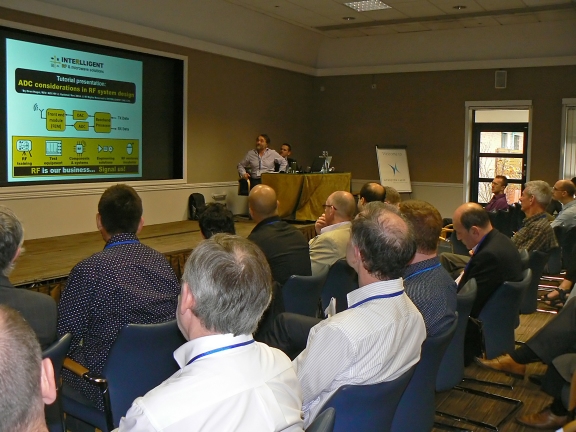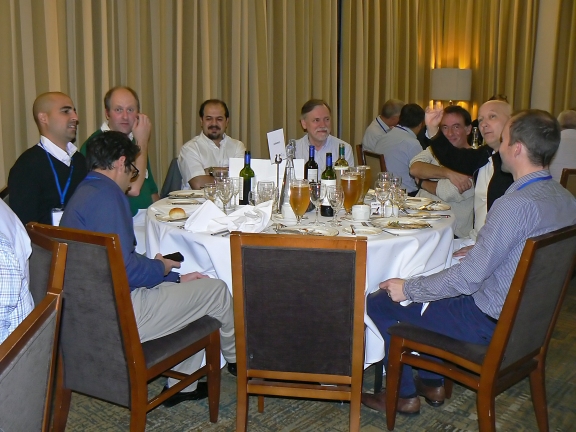The November 2014 meeting will took place at Wyboston Lakes
Young Engineer Sponsorship: The ARMMS RF & Microwave Society offers sponsorship to young engineers (28 or below) who have papers accepted for presentation. Sponsorship is £100 cash plus free attendance (including conference dinner and overnight accommodation). Two young engineer sponsorships were awraded at this meeting: Mohamed Ismaeel Maricar of De Montfort University and Tianhao He of Birmingham University
Best Paper Award: The Steve Evans-Pughe prize is awarded to the best presenter at each meeting. The award is £200 for the best paper and £50 for the runner-up. The prize is sponsored by AWR.. For the first time there was a dead heat. The winners were Tianhao He of Lancaster University and Peter Beeson of LA Techniques.
Lego Mindstorm: This meeting will featured a free to enter prize draw for a Lego Mindstorms. The prize is provided by test equipment rental and RF support services provider Interlligent UK - the winner was Tom Scanlon of Farran Technology.
For all enquiries please email enquiries@armms.org
 |  |  |
Wyboston Lakes
Great North Road
Wyboston
Bedfordshire
MK44 3AL
| Tel | 0333 7007 667 |
| sales@wybostonlakes.co.uk. | |
| Web | http://www.wybostonlakes.co.uk/ |
Mark Ashcroft
Pico Technology
A 9-10GHz 25W GaN Quasi-MMIC PA in QFN Package | |
| Jonathan Leckey | |
| MACOM | |
A single stage X-band (9-10GHz) PA module has been developed using a discrete 0.25um GaN transistor with 4.8mm gate periphery, that incorporates input and output matching via discrete substrates in package. The initial demonstrator module achieves 25W of power under pulsed conditions at 9.5-10GHz with Vds=40V, a peak efficiency of 44% and small signal gain of around 12dB. The PA was assembled in a 5mm overmolded QFN package. The power density and peak drain efficiency are in reasonable agreement with the process pcm performance at this frequency, given output matching losses have to be accounted for. This work demonstrates the feasibility of prematched GaN transistors and MMIC-like modules in high volume SMT packaging and to a frequency of 10GHz. | |
| A 9-10GHz 25W GaN Quasi-MMIC PA in QFN Package | |
Activity in the WiFi bands - An Objective Approach to Estimation | |
| Simon Day | |
| Phasor Design / MASS | |
A survey of IEEE 802.11 WiFi usage in the 2.4 GHz and 5 GHz bands has been carried out by Ofcom with a view to gaining a clearer understanding of the state of these Licence-Exempt spectrum bands. The very large amount of data was gathered was analysed by MASS Consultants who had the challenge of deriving meaningful results and insights. The study concluded that the majority of this network degradation is probably attributable to the interference between WiFi networks in an unmanaged environment rather than interference from other technologies such as Bluetooth, analogue video senders and microwave ovens. | |
| Activity in the WiFi bands - An Objective Approach to Estimation | |
ADC Considerations in RF System Design | |
| Oren Hagai | |
| INTERLLIGENT | |
Broadband Analog to Digital Converters (ADCs) are key building blocks in modern receiver design. Although broadband ADCs share some “traditional” parameters and design rules which are similar to conventional analog blocks in the RF chain, they also introduce their own set of unique behaviors and design rules caused by sampling and quantization. This presentation from test equipment rental provider Interlligent UK (VNA rental,spectrum analyser rental and signal generator rental) will discuss some of these unique attributes and their influence on RF system design. It will cover the ADC’s dynamic range and how this effects the performance and design choices for the whole RF Front end, Real-IF and Zero-IF receiver frequency plans, linearity budget and noise budget. It will also review some popular ADC architectures used in receivers and discuss the relative merits. | |
| ADC Considerations in RF System Design | |
An Investigation into the Effects of Sampling on the Loop Response and Phase Noise in Phase Locked Loops | |
| Peter Beeson | |
| LA Techniques Ltd | |
The majority of Phase Locked Loop IC manufacturers provide simulation software to enable the performance of their ICs to to be evaluated. These simulation packages use a continuous time model to calculate the loop response and predict phase noise performance. When the loop bandwith is relatively large compared to the comparison frequency this model becomes less accurate and the effect of sampling must be taken into account. This paper compares the results of the continuous time model and the sampled model and introduces a base-band circuit that simplifies the process of making measurements to support the simulations and provide further insight into the effects of sampling. | |
| An Investigation into the Effects of Sampling on the Loop Response and Phase Noise in Phase Locked Loops | |
Calibration of an Anechoic Chamber for Measurement of a Multi-Channel Antenna | |
| Tamara Sheret and Ben Allen | |
| University of Bedfordshire | |
Anechoic chambers are structures which simulate testing in free space and are used to measure the radiation pattern of an antenna. This paper presents a methodology to measure the radiation properties and hence determine the gain of a multi-channel antenna in an anechoic chamber. This gives an unique extension to current practice that is only suitable for a single channel antenna. The process to measure the loss through an anechoic chamber measurement system and the gain measurement of a multi-channel antenna are presented and a measurement procedure is recommended. | |
| Calibration of an Anechoic Chamber for Measurement of a Multi-Channel Antenna | |
Interpolation of Sets of Traces Acquired from DSO and RTDO Oscilloscopes | |
| Manuel Rodriguez-Higuero | |
| Instituto Nacional de Tecnica Aeroespacial (INTA) | |
In this paper we present some examples of traces acquired by Real-Time (RTDO) and Sampling (DSO) Oscilloscopes. Key difference between them is the way in which the traces are acquired: sampling oscilloscopes essentially reconstruct the waveform from samples acquired along different periods of the time signal: this has implications in the definition and thus in the modelling of jitter as unwanted contribution. We analyse these differences in terms not only of the simulated traces in the time domain, but also looking at the dispersion of harmonics in the frequency domain, and also in terms of the associated covariance matrix. A second topic here analysed is the determination of the minimum number of harmonics / time samples needed to keep the basic information contained in a given set of traces. Interpolation and / or decimation in both the time and in the frequency domains will help us answer this question. | |
| Interpolation of Sets of Traces Acquired from DSO and RTDO Oscilloscopes | |
Ka-Band 4W Power Amplifier MMIC | |
| Thomas Young | |
| MACOM | |
The measured performance of a Ka-band power amplifier MMIC is presented. The MMIC was fabricated using a 2mil 0.15um GaAs pHEMT process. The design achieves saturated output power in excess of 36dBm over a bandwidth of 32 – 38 GHz, with a PAE of 23%. The part specifications exceed competitor performance in terms of chip size ratio and power. The measurement reference plane includes the bond wire transition on and off the die with a probable substrate used for test. | |
| Ka-Band 4W Power Amplifier MMIC | |
Miniature Ceramic Thin Film Filters | |
| Gavin Ripley | |
| BSC Filters Ltd | |
This presentation describes the design and manufacture of surface mount miniaturised filters offering performances up to 20GHz+. The process of "prototyping before manufacture" will be described, based on a realisation on high dielectric constant ceramic substrate using a 3D solver together utilising full characterisation of surface conductivity, substrate dielectric constant and carrier circuit board interactions. Manufacturing of these filters uses Industry standard MIC processing techniques which will be illustrated together with preproduction prototype parts and test data. | |
| Miniature Ceramic Thin Film Filters | |
Non-Binary Power Dividers | |
| John Kitchen | |
| S J Technologie | |
Most power dividers are binary in that they offer 2, 4, 8 or 16 way division of the input signal. | |
| Non-Binary Power Dividers | |
RF Interference Cancellation - a Key Technology to support an Integrated Communications Environment | |
| Steve Nightingale | |
| Cobham Technical Services | |
This paper describes some of the recent developments in the application of RF interference cancellation techniques to enable an Integrated Communications Environment (ICE). It is well known that the high levels of mutual coupling between antennas on small fixed or mobile platforms causes significant levels of power from the transmitting radios to be coupled to those operating in the receive mode. This can cause compression, overdriving, and, in some cases, permanent damage to the radio front ends. The large transmit signals can be reduced to acceptable levels by RF interference cancellation. However, once this has been achieved, the sensitivities of the receiving radios are frequently limited by the transmitter sideband noise. This presentation will describe the development and application of both large signal and noise cancellation techniques to maximise the sensitivity of all receiving radios on the same platform. Examples are given based on radio equipment installed on typical mobile military platforms. | |
| RF Interference Cancellation - a Key Technology to support an Integrated Communications Environment | |
Second Harmonic Extraction of Planar Gunn Diode by Using Resonators for Millimetric Wave Applications | |
| Mohamed Ismaeel Maricar, C. H. Oxley, AtaKhalid and D S R Cumming | |
| De Montfort University, Glasgow University | |
Indium gallium arsenide (InGaAs) planar Gunn diodes with on chip matching circuits were fabricated on a semi-insulating Indium phosphides (InP) substrate. Radial and diamond stub resonators were used as circuit elements to suppress the fundamental frequency and allow the second harmonic frequency to be extracted from the planar Gunn diode. The extraction of the second harmonic will enable the planar Gunn diode to operate at millimetre wave and terahertz frequencies. InGaAs planar Gunn diodes were fabricated with an active channel length (anode to cathode separation) of 4 µm and a width of 120 µm. The experimental results gave a second harmonics signal at 118 GHz with an RF output power of -20 dBm for the radial stub resonator, and 121 GHz with an RF output power of -14.1 dBm for the diamond stub resonator. This is the highest second harmonic power recorded for a planar Gunn diode. The results indicate the potential of terahertz operation by reducing the channel length to sub-micron and extracting the second or third harmonic from the planar Gunn diode. | |
| Second Harmonic Extraction of Planar Gunn Diode by Using Resonators for Millimetric Wave Applications | |
Shrinking the Quartz Crystal Resonator | |
| Chris Watts | |
| Golledge Electronics Ltd | |
As with the rest of electronics there has been a move from leaded packages to surface mount and ever smaller packages. While the consequences for this change have been slight for other passive components, crystals do need some design adaptions as the size of the chosen crystal is reduced. | |
| Shrinking the Quartz Crystal Resonator | |
Submillimeter Rectangular Waveguides Based on SU8 Photoresist Micromachining Technology | |
| Tianhao He and Michael J. Lancaster | |
| University of Birmingham | |
Rectangular waveguides are fundamental structures for transmission of signals and for the construction of passive circuits. This paper describes the design and measured results for two rectangular waveguides based on SU8 photoresist micromachined technology, with double-layer fabrication and partial coating techniques to minimise the air gaps between layers. A brief description of the SU8 photoresist micromachining procedure is given in the paper. One waveguide is demonstrated for the WR3 band from 220 GHz to 325 GHz, which is made of SU8 photoresist with a novel 3 piece construction with top and bottom two layers joined to form the whole 5 layers structure. The other is for the WR6 band 120 GHz-170 GHz with a new 3 pieces construction assembly with a 5 layer structure. Both waveguide have novel bends in order to connect the measurement apparatus. The measured performance is presented and compared to conventional machined metal waveguide structures. The measurement results of insertion loss show both waveguides are better than 0.03 dB/mm. | |
| Submillimeter Rectangular Waveguides Based on SU8 Photoresist Micromachining Technology | |
The RF Challenges of Air Traffic Control Communications | |
| David Hand | |
| Park Air Systems Ltd | |
This paper presents a typical setup of civilian ATC communications networks and the challenges this gives the RF systems engineer as well as the radio designer. | |
| The RF Challenges of Air Traffic Control Communications | |
What are the Limits to Increasing the Dynamic Range of RF ADCs? | |
| Allan Belcher | |
| Cardiff University | |
This paper puts forward a figure of merit concept that relates ADC data sheet specifications to RF performance. It will indicate where future trends exist and outline a signal processing method that enables resolution in bits to be traded for sampling frequency while maintaining the figure of merit. The paper will also review the effectiveness of signal processing methods in increasing spurious free dynamic range. | |
| What are the Limits to Increasing the Dynamic Range of RF ADCs? | |
Companies booking two or more delegate places are able to take part in the commercial exhibition that accompanies the conference. Please note that there is a maximum of 20 exhibition tables at each meeting, these are offered on a first come basis. If you are interested in exhibiting at future meetings please email exhibition@armms.org to reserve space.
If your company is interested in sponsoring the November 2014 meeting please email enquiries@armms.org
Contributions are invited with an emphasis on RF and microwave design, research, testing and associated subjects. An oral presentation will be made at the meeting and a written paper will be required for publication in the society digest, which is distributed to delegates at the meeting. Prospective speakers are requested to submit a title and a short abstract to the technical coordinator (see above) as soon as possible.
Click here to view our Guidelines for Authors
Click here to view our Publication Release Form